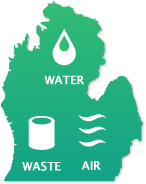
Characterization of Hazardous and Regulated Waste in West Michigan
Be aware Michigan regulations identify more hazardous wastes than US EPA under the federal regulations. Waste characterization information helps in planning how to reduce waste, setup recycling programs, and conserve money and resources. Businesses need to determine if the waste they generate is hazardous or non hazardous. If the materials used, or the process generating the waste changes, or there are other impacts from business operations that may change the waste, it will be necessary to re-evaluate the waste characterization. Waste characterization means finding out how much solvent (flammable), metals, oil, coolant, corrosive, poisons, reactive, antifreeze, etc. is discarded in your waste stream or keep on site.
WASTE CHARACTERIZATION STEP ONE
First, we conduct a waste survey to identify all your waste streams. Hazardous waste may be generated in many
areas of your business from the shop floor to offices. Following are some commonly overlooked wastes with potential hazards.
Facility or Shop Hazards and Solids
- Spent fluorescent tubes and other lighting fixtures (toxic for mercury).
- Disposable rags containing free liquids with a flash point of less than 140 degrees Fahrenheit or used with a listed solvent (ignite ability, spontaneous combustions, used with “F” listed solvents).
- Aerosol cans that are not empty (contains U or P chemicals, ignite)
- Solvent-based adhesives (igniteability).
- Batteries-lead acid and dry cell (toxic for lead and mercury, corrosive).
- Listed wastes mixed with another non hazardous waste. (toxic metals of concern include lead, chromium, cadmium, and barium).
- Office computer equipment (my contain lead in the cathode ray tubes, mercury switches, batteries)
- Discarded, unused chemical products from inventory reduction activities (any of the commercial chemical
products on the P and U listed in the state or federal regulations).
Storm Water and Air Quality Hazards and Fluids
- Used water-based or synthetic lubricating fluids containing high concentrations of heavy metals
- Used solvents with low flash point (toxic, ignite).
- Used solvents with high flash points (toxic and ignitable contaminants).
- Drain or sump sludge, including loading/unloading area trenches (contains toxic metals or F solvents, ignite ability due to gasoline from trucks).
- Painting materials and waste including paint thinners, enamel reducers, epoxies, primers, enamels, solvent-based
paints, and paint booth filters (contains F solvents, metals, ignite). - Spent activated carbon media, included in some air filters and other equipment (contains F listed solvents).
- Medical kits containing mercury thermometers or antiseptics containing mercury (toxic).
Identify if the material is a characteristic and/or listed hazardous waste as identified in part 2: Identification and Listing of Hazardous Waste of the hazardous waste rules and part 111, Hazardous Waste Management, of the Natural Resources and Environmental Protection Act 1994 PA 451 (NREPA).
WASTE CHARACTERIZATION STEP TWO
Resource Conservation and Recovery Act (RCRA) and Rules
- Is the unwanted material a waste (solid, semisolid, liquid, or gas)?
- Is the material specifically excluded or exempted from the hazardous waste regulation?
- Is the waste a listed hazardous waste? To be considered listed waste, either the chemical or the process to generate the waste is specifically included in the rules. Listed wastes include F, K, P and U in the hazardous waste number. In some instances, if listed hazardous waste is combined with other non-hazardous wastes, those wastes may be regulated as listed hazardous waste.
- Does the waste exhibit a characteristic of hazardous waste? The waste could be flammable, corrosive, reactive, or it meets or exceeds the toxicity levels identified for 40 materials identified in administrative rule R299.9217 and materials listed in R299.9219. Characteristic wastes include “D” and “S” in the hazardous waste number.
- Is the waste subject to the Land Disposal Restrictions (LDR).
If the waste is not hazardous waste, does it contain free liquids which would make in a Part 121 liquid
industrial waste in Michigan? Does it meet any exclusion listed in Part 121? If you are unsure if liquids are
present, it may be necessary to have a paint filter test done. Please note used oil has requirements under
both parts 121 and 111. process wastewater discharged to a septic system is normany regulated as Part
121 waste and not Part 117 septic waste, and that septic system may need a round water discharge permit
from that DEQ Water Bureau
If it is not hazardous wasted or a liquid industrial waste, is it a Part 115 solid waste or Part 169 scrap tire
or NESHAP regulated asbestos waste? Does it meet any exclusion included in these regulations? See
the MDEQ website about landfill prohibited wastes.
In some instances, it may be necessary to determine if the material is a regulated medical waste or
radioactive material waste or regulated under the federal Toxic Substances Control Act (TSCA) such as
PCB waste.




